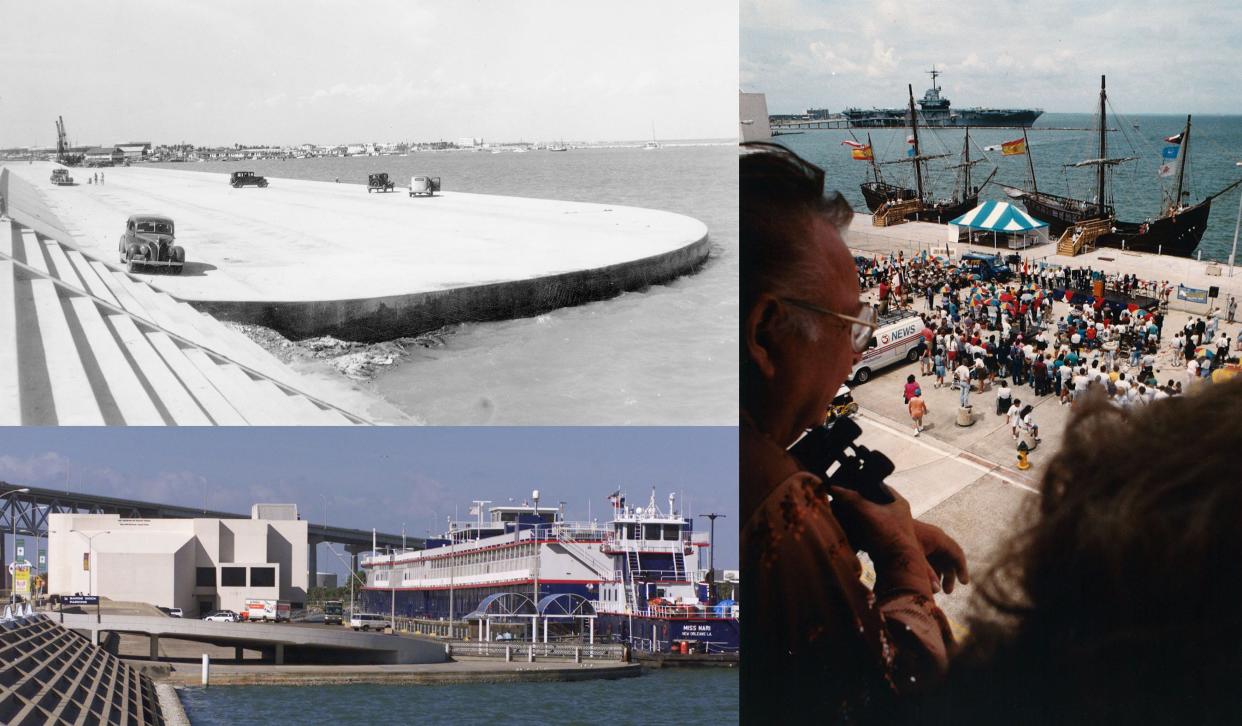#TBT: Corpus Christi's barge dock site of city happenings since 1940

For an unassuming stretch of concrete, the city’s barge dock at the end of the seawall has been the site of a number of community events and controversies in Corpus Christi’s history.
As work progressed on the new seawall construction in the late 1930s, engineers had determined a section of footing at the northmost end of the project would be unsuitable for continuing the seawall. So city leaders decided that section, which began at Hughes Street, could sustain a barge dock instead. In June 1939, Mayor A.C. McCaughan gave an assurance that the city did not intend to compete with the Nueces County Navigation Commission, the original name of the Port of Corpus Christi’s governing body.
“We might lease the dock space to the navigation commission, but we don’t expect to handle it on a competitive basis at all,” McCaughan stated.
Instead, McCaughan hoped to catch some of the new traffic expected when the Corpus Christi section of the Intracoastal Waterway was completed in 1942.
Doc McGregor captured a photo of the nearly completed barge dock in August 1940, showing cars already using the new space on the bayfront. But motorists didn’t always exercise a lot of caution, and two cars rolled into the bay in January 1941. Luckily none of the drivers or passengers were severely injured, since the water was only four feet deep in that area, and workers installed guard rails in the ensuing months to prevent further auto diving accidents.
More: #TBT: Bayfest was a Corpus Christi favorite for more than 30 years
The first few years saw the barge dock mostly used as extra viewing areas for Buc Days water festivities like the motorboat races. In 1947, the LST 512, known as the Navy’s “Thank You” ship, tied up at the barge dock as part of its nationwide tour. Visitors spent four days strolling through the ship’s exhibits that explained military tactics used during World War II, camouflage techniques from the Pacific theater and Japanese military equipment.
With the oil and gas boom of the 1950s, the barge dock began to see more use from companies drilling for oil in the bay. The practice caused a number of controversies, with complaints from nearby motel operators and guests about the noise created by equipment and trucks driving to and from the dock.
In 1965, members of the local International Longshoremen Association unions picketed the dock during a strike. Since the city barge dock was not operated by the port, the city allowed barges to unload with non-union workers at the city-owned dock. The picketers attended city council meetings to request the city revoke the company’s permit, but the council refused. The city was even accused of undermining port tariffs by allowing storage of oil and gas equipment.
“There’s no tariff on the city dock for storage. It’s some kind of deal where somebody calls somebody and gets an OK,” George Hartley, the union’s business manager, told the Caller-Times in May 1965. Eventually the equipment was moved and the city stopped using the barge dock for storage and offloading.
More: Throwback: Columbus ships saw anything but smooth sailing in their Corpus Christi odyssey
In 1972, the dock got a new neighbor when the Art Museum of South Texas opened next door. The Bayfront Convention Center and Auditorium then opened across the street in 1980.
The barge dock saw scores of visitors when Los Barcos, replicas of Christopher Columbus’ ships made for the 500th anniversary of his voyage, visited the city from Spain in March 1992. The city recorded more than 107,000 visitors during the ships’ 10-day stay in Corpus Christi, prompting the city to purchase the replicas for permanent display.
Bayfest, the downtown fall festival that ran from 1976 to 2010, also used the dock for a number of exhibitions and stages through the years. For the pop culture crowd, the barge dock was the site of an attempt to break a record for most people dancing the Macarena on Sept. 22, 1996 during Bayfest. The 39,500 people who showed up to dance during the Bayside Boys performance failed to beat the record of 50,000 at Yankee Stadium.
In the 1990s and again in the 2010s, the Regional Transportation Authority operated water taxis off the dock, running passengers over to North Beach so they could visit the Texas State Aquarium and USS Lexington Museum, but ridership remained low enough that the cost of fuel and maintenance couldn’t be justified.
And though not a site of heavy commerce anymore, the barge dock continues to host the occasional water traffic, anglers, and museum visitors today.
Allison Ehrlich writes about things to do in South Texas and has a weekly Throwback Thursday column on local history.
This article originally appeared on Corpus Christi Caller Times: Corpus Christi barge dock has been site of union fights and Macarena

